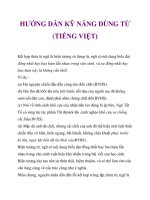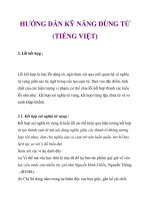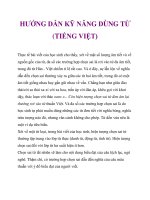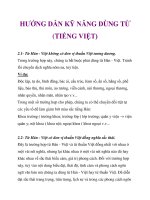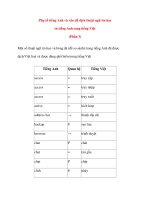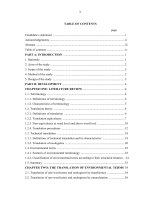Tiểu luận Dịch Anh - Việt thuật ngữ về thẻ tín dụng
Bạn đang xem bản rút gọn của tài liệu. Xem và tải ngay bản đầy đủ của tài liệu tại đây (351.44 KB, 74 trang )
English-Vietnamese translation of terminology on credit card
- 1 -
CHAPTER ONE: INTRODUCTION
1.1. Background to the study
1.1.1 Rationale
It was a milestone in my life when I passed the hard entrance exam
to the English class of my province's high school for gifted students. During my
study there, I had a good chance to be exposed to the English language
environment where I accumulated English a lot. My passionate love for the
English language remains and just grows more strongly day by day during my
time spent at the English Department, Hanoi University of Foreign Studies. In
the last three university terms namely term 6, 7 and 8, English students of the
academic year 2002 including me have been trained in Translation and
Interpretation course, and I immediately took special pleasure in translating,
especially from English into Vietnamese. Within three terms only, we have been
introduced to a wide range of fields that we may encounter in our future jobs
such as diplomacy, politics, economic issues, finance and banking, environment,
social development, etc. We all find these thoroughly selected topics are of great
application to us due to their frequent use in the current affairs locally and
globally. Truly speaking, when practicing translation at class, we have the
feeling that the deeper scopes of life we touch on, the greater challenge we are
confronted with. In fact, the problem may not lie in the language itself but in the
background knowledge containing in the source language text required to
produce a comprehensible and professional translated version. Thus, in the very
initial stage of translation learning, I myself find it extremely hard to deal
successfully with terminologies arising in the English version. In reality, all
professions have their own system of "jargons" and translators normally have no
English-Vietnamese translation of terminology on credit card
- 2 -
desire to equip themselves with all such technical terms. However, it requires a
translator to master terminology of the area he/she specializes in to facilitate
his/her translation job. During my university, I am especially interested in the
field of banking and finance that is, as for me, implicit tremendous challenges,
and difficulties in terms of language. I always look forward to having a chance
to go inside the world of banking and finance language, discover and resolve
translation obstacles set by banking and finance terminology. However, Banking
and Finance is a huge topic that holds thousands of concepts and has a range of
thousands of terms. Therefore, I come up with a smaller topic and expect to deal
with it in details within my Graduation Paper, which is "A study on English-
Vietnamese translation of terminology on credit card." Credit card has been in
use for years in the world, however, in Vietnam it is relatively a newly
developed banking product. Hopefully, my small research may be of little use to
students of English in our department or anyone concerned about banking and
finance, especially credit card.
1.1.2. Aims and scope of the study
I strive to do my research with the aims of:
- Giving the general overview of terminology and methods applied in the
translation of terminology
- Helping readers have more understanding of credit card in general
terminology on credit card in particular
- Analyzing the translation of credit card terminology
Credit card is one small aspect among various bank products and services
nowadays. However, it is not an easy job to understand clearly and profoundly
how it works and benefits individuals and the economies to render correctly and
English-Vietnamese translation of terminology on credit card
- 3 -
understandably all terms related to such industry into Vietnamese. Due to my
limited knowledge and the rapid development of credit card in the dynamic
financial market today, shortcomings and mistakes in credit card terminology
are inevitable. Thus, any comment, correction, and constructive ideas by my
fellow students, teachers and readers to further complete my research are deeply
appreciated.
1.1.3. Methods
In a bid to write a good Graduation Paper, it is vital to start on the right
track and carefully outline a sound and effective method of doing a research.
The research has been conducted on the ground of studies on terminology
by many foreign and Vietnamese linguists and scientists. The theoretical
background is built on the basis of their scientific reports, statements and books
on terminology and the translation of terminology.
In addition, online and offline dictionaries and encyclopedia are also
consulted to build a complete glossary on credit card. I obtain much knowledge
of Credit card and collect additional terms from Reference books, Journals,
Publications by quite a few banks in Vietnam. Especially, I have tried hard to
contact and have unofficial interviews with bankers of some commercial banks
in Vietnam to obtain hands-on understanding of credit card and get to know
more about credit card terminology.
1.2. Organization
This Graduation Paper is divided into four Chapters. Chapter I
introduces the background and organization of the study. Chapter II makes an
overview of related literature concerning theory on terminology, the translation
English-Vietnamese translation of terminology on credit card
- 4 -
of terminology. Chapter III presents firstly an overall look on credit card and
credit card terminology, then the translation of credit card terminology that
concerns Literal and Communicative translation , and the analysis of the
equivalence. Chapter IV will wrap up the study with the conclusion.
English-Vietnamese translation of terminology on credit card
- 5 -
CHAPTER TWO: REVIEW OF THE LITERATURE
2.1. An overview of terminology
2.1.1. Definition of terminology
Since the topic of the graduation paper reads "A study of English-
Vietnamese translation of terminology on credit card”, apparently the word
"terminology" should appeal to any reader who happens to rest his eyes on the
cover of the research as the core point of the work. A question will then be
raised thereby "what is terminology?" or "Do the word “term” and
“terminology” mean the same thing?" It is necessary to bring these questions to
light within the limited scope of the study.
According to Oxford Advanced Learner Dictionary, term is "a word or
phrase used as the name of something especially one connected with a
particular type of language." Also this dictionary defines terminology as "a set
of technical words or expressions used in a particular subject." As such,
terminology is broader in meaning compared with term. While terms separately
refer to discrete conceptual entities, properties that constitute the knowledge of a
particular field, terminology refers to the system of all concepts and definitions
concerning a specific technical area. As defined in this way, credit card
terminology must be a set of terms relating to credit card, a banking product that
has facilitated payments worldwide.
Quite a few senior Vietnamese linguists have also proposed other definition
of terminology as follows:
English-Vietnamese translation of terminology on credit card
- 6 -
• Terminology is a word or a word-group used in science,
technology, politics, diplomacy, art, etc., which exactly indicates a
concept or a title of a particular.
(Nguyen Van Tu, 1960: 176)
• Terminology is a part of special words of language. It consists of
certain words and phrases that are the exact names of a variety of
concepts and objects, which belongs to the professional field.
(Nguyen Thien Giap, 1986: 223)
In brief, unlike ordinary words, terminology or a set of terms are regarded
as scientific words and each term denotes a concept in a particular field such as
economics, biology, chemistry, and so on. Ordinary words often convey more
than their literal meanings and evoke further images, emotions, and reactions on
the part of listeners or readers, whereas terms are largely free from such
distorting associations.
2.1.2. Features of terminology
It is of common knowledge that most of the layers of vocabularies have
their own features and are used in certain situation by particular groups of
people. That is also applied to terminology. Đỗ Hữu Châu (1981) in his book Từ
vựng tiếng Việt hiện đại or Modern Vietnamese Vocabulary has defined three
main characteristics of terminology including Accuracy, Systematicality and
Internationality.
• Accuracy
A concept represented a term must be clear and exact. In addition, an
accurate term should not make the reader misunderstand the concept it expresses
with another. Actually the accuracy of terminology is well recognized in both its
form and meaning.
English-Vietnamese translation of terminology on credit card
- 7 -
With respect to the lexical meaning of words, normal word often bear the
characteristics of polysemy and synonym, whereas terminology must keep away
from this. The semantics of ordinary words may change in different usage and
contexts while that of terminology is fixed in specialized fields it is employed in.
For example, a normal and simple noun like "school" in general language has up
to eight shades of meanings when used in different circumstances. However, the
term "pneumonia" in medicine is taken for one single meaning "a serious illness
affecting one or both lungs that makes breathing difficult."
As regards the accuracy of terminology in terms of form, terminology has
no other form or outer cover other than its original one. We can hardly add any
factors like prefix, suffix, etc, to a term to refer to the plural form, antonyms, or
any change in word meaning. For example, the above-mentioned word
"pneumonia" does not allow any transformation to its form. However,
considering systematicality (that will be further discussed in the next part), the
form of a term could be changed, but in a special way.
In fact, the accuracy of terminology has, to some extent, changed along
periods of history. For instance, the term "consult" in Roman time means "quan
chấp chính", however, it is understood in recent modern time as "tổng đài" and
in modern time as "lãnh sự". Besides, the accuracy of terminology does not
require one-to-one relationship in translation. This means a term in source
language (English) may be equivalent in two (or more) terms in the target
language (Vietnamese). For instance, the term "tongue" in English could be
translated as "lưỡi" or "tiếng" in Vietnamese. Thus, it is important for translators
to be cautious about the accuracy of terms when doing translating or interpreting
job. They should closely observe the principle "each term represents one concept
and vice versa." Undeniably, homophones and synonyms may exist in the
English-Vietnamese translation of terminology on credit card
- 8 -
terminology of various fields, however, they do not degrade the accuracy of
terminology itself.
• Systematicality
As defined above, terminology is "a set of technical words or expressions
used in a particular subject." This means terminology of a specific profession
should include terms that are closely related to each other and reflect a system of
concepts of the profession. The relation between them can be based on contrast
in meaning: "negative and positive", "male and female", "final sounds and initial
sounds"; similarities in meaning: "securities, stocks, bond, debenture, share";
dominant and secondary meaning: "lexis" and "noun, pronoun, verb, adjective,
conjunction, preposition, adverb", etc.
A system of terms not only meets general requirements but also satisfy
particular ones posed by certain specialized it reflects. As a matter of facts, each
field of science has it own systems of solid and finite concepts, expressed by it
own terms. The semantic value of a term is determined by its relation to others
in the same field. Therefore, once isolated, the term may have no or ambiguous
meaning. However, there exist homophones and synonyms among term systems
of different fields. For example, "floor" in architecture means "sàn nhà", while
in banking is defined as "tối thiểu".
The systematicality also requires a term itself to be systematic in its own
meaning. To this end, terms are usually short in form. For instance, "chứng lang
thang trong tình trạng mê ngủ" is named "mộng du", "người lái máy bay" is
called "phi công", or terms like "affix, prefix, infix, suffix" represent bound
morphemes that are added to different positions within a word.
English-Vietnamese translation of terminology on credit card
- 9 -
In sum, systematicality makes terms the insiders of a particular field and
helps us understand concepts that terms express.
• Internationality
The internationality is recognized in both form and meaning of
terminology.
With respect to such characteristics of terminology in term of meaning,
terminology denotes common scientific concepts shared and equally understood
by speakers of different cultures. This feature is an important property that helps
distinguish terminology from other layers of vocabulary such as slang, dialect,
etc. Terms denote universal concepts of a certain subject, whereas normal
lexical items are confined to various limits of expression, context, and culture
differences.
The internationality is also seen in the form of terms. It is interesting to
know that many terms used by different countries have similar phonetic form.
For example:
Terminology English German French
Amip amoeba amode amibe
Nhôm aluminium aluminium aluminium
Vi khuẩn bacteria bakterie bactérie
Vitamin vitamin vitamin vitamine
The similarities in form of terms are due to various causes including
geography, tradition, history, or language habits. To put it more clearly,
English-Vietnamese translation of terminology on credit card
- 10 -
terminology in scientific subjects is often originated from Latin and Greek
languages. In contrast, Vietnamese and Eastern Asian countries have terms
based on Chinese-rooted words, which can be explained by their close relation
with China in both geography and culture.
Acronyms also contribute to the internationality of terms. They are widely
used and easy to remember to people in all countries they reach.
For instance: Khí CFC, CFC stands for chloflouro carbon
Hệ thống thanh toán ACH, ACH stands for Automated Clearing
House
Máy ATM, ATM stands for automatic telling machine
Finally, the internationality could make terms quickly shift into normal
words and become non-standardized language. The internationality of terms
helps promote and accelerate the irreversible trend of global integration today in
term of language as well as other fields. Because language is actually the bridge
linking people of nations in the world and the popularity of a common language
through terms contributes to the transfer of science and technology worldwide.
Terminology on credit cards bears all these common features of
terminology. It is above-mentioned specific characteristics of terminology in
source language (English) that determine suitable translation methods applied to
produce exact Vietnamese terms.
2.1.3. Norms of Vietnamese terminology
Controversy has risen upon which standards Vietnamese terminology
should follow. L.K Kế in his book “Tiếng Việt và dạy học bằng tiếng Việt”
(Vietnamese and teaching in Vietnamese) puts it that Vietnamese terminology,
English-Vietnamese translation of terminology on credit card
- 11 -
in the first place should be scientific, accurate, systematic, then popular,
applicable, and of native language in accordance with characteristics of
Vietnamese. Meanwhile, according to L.V Thới, a noun that is used in particular
subject must belong to such field linguistically and practically, and as concise
and simple as possible. Therefore, he said, the noun must be monosemy (has one
meaning) and a concept should be expressed by one noun.
In the final analysis, the conference on terminology held in Ha Noi, 1967
by the State Committee of Science came to a unanimous conclusion that the
Vietnamese terminology is to be:
1. Systematical
2. Linguistically native
3. Accurate
4. Concise
5. Popular and of great utility (comprehensible, memorable, easy to
speak, write and edit)
Generally speaking, Vietnamese terminology bears the same features to
English ones. It expresses exactly one concept; rarely has synonyms or
polysemy; and is popular among its users.
In terms of the origin of Vietnamese terminology, Vietnamese
terminology is made up of four components namely Pure-Vietnamese words,
Sino-Vietnamese words and Indo-European words.
English-Vietnamese translation of terminology on credit card
- 12 -
• Pure-Vietnamese words are generally original Vietnamese ones and
they express the fundamental, popular objects, phenomena in informal
manner. For example: cha, mẹ, cây, củ, quả,
• Indo-European words are borrowed from Indo-European family.
When integrating into Vietnamese, some are changed in terms of
pronunciation, some are not. For instance, Internet, hydro, xà phòng, bít
tết, oxy, violon, etc.,
• Sino-Vietnamese words are Vietnamese words of Chinese
derivation. During a thousand years under the domination of China,
Vietnamese language absorbed a great number of Mandarin lexical items.
Gradually, Vietnamese language was assimilated, and it received
Mandarin lexicon through both communication and education. Sino-
Vietnamese words account for a great proportion of Vietnamese
vocabulary and has been used widely in daily life. For example: xạ thủ,
hoàng thượng, lãi suất tối thiểu, thấu chi, etc.
Above features of Vietnamese terminology has helped translator a lot in
deciding most suitable methods of translation when it comes to handling
difficult terms in general and terms on credit card in particular. Notably, the use
of Sino-Vietnamese word has been especially exploited in their translation work.
Within limited scope of this Graduation Paper, only the use of Sino-
Vietnamese in the translation of terminology, especially credit card terminology
is considered in details.
English-Vietnamese translation of terminology on credit card
- 13 -
2.1.4. The importance of study of terminology translation
Although terminology, according to Peter Newmark, accounts for only 5-
10% of words in a written or oral text, I think, the mastery of such tiny
percentage terminology will determine the success of the translating work. Only
two following reason can possibly illustrate such idea.
First, studying terminology of one specific area means to learn the general
knowledge about this field and most of its concerned issues. In a sense,
acquiring a language is not simply implicit that we are learning the language
itself. In fact, what is more important is to acquire a language together with
things behind it like rich information it conveys. This is well proved in the
process I study terminology on credit card. Although credit card is among many
products and services of banks, I have to get to know how a bank operates, why
banks come into being, by what way a bank get profits on money, etc., many
things that I have never encountered before. Simply if I have no understanding
about banks, I can hardly get any terms on credit card into my mind.
Second, the mastery of terminology in a particular subject and the
common way to convert them into Vietnamese is very helpful in using terms
accurately, precisely and with expertise. This helps translators avoid
embarrassing situations where they are confused with new, strange, and difficult
terms.
Besides, through studying terms of one profession, we will get familiar
with abbreviations that are well known to people working in this field but quite
unfamiliar with outsiders. I myself also had a "bad" experience about this. When
I received my ATM card with a set of usage instruction from the bank that
issued it, I caught the word "PIN". I thought the word was something related to
English-Vietnamese translation of terminology on credit card
- 14 -
battery. However, in fact, it stands for Personal Identification Number. As an
English student, I felt somewhat a shame when I discovered the truth. Honestly
speaking, when a term has become popular in daily life, getting to know it is not
only the job of translators.
Evidently, the study of terminology in a specific field will enrich our
vocabulary, helps us to use them in an accurate, concise, flexible manner and
finally results in professional and effective translation. Therefore, translators
should be skilled in dealing with terminology to smooth their work. Anyway, 5-
10% is just statistical figures on average. In fact, the frequency of terminology
appearance in some areas is much higher or lower than others. Thus, the study of
terminology is of great importance, especially when translators are about to
undertake jobs in a brand new field.
2.2. The translation of terminology
2.2.1. The technical translation
The translation style dealing with terminology in specific fields such as
politics, economics, banking and finance, law and so on is called technical
translation. According to Peter Newmark (1995), "technical translation is
primarily distinguished from other forms of translation by terminology. Its
characteristics, its grammatical features merge with other varieties of language.
Its characteristics format is technical report, but it also includes instructions,
manuals, notices, publicity, which put more emphasis on forms of address and
use of the second person." He divides technical translation into three levels that
he finds of great application: Academic, Professional, and Popular
English-Vietnamese translation of terminology on credit card
- 15 -
• Academic
This includes transferred Latin and Greek words associated with academic
papers such as scientific writing or university students' textbooks
For example: In medicine
Pediatrics : Khoa nhi
Geriatrics : Khoa nội tiết
Cardiovascular disease : Bệnh tim mạch
• Professional
Formal terms used by experts. However, they may be understandable to others.
For example: In jurisprudence
Criminal court : tòa hình sự
Civil court : tòa dân sự
Court of Appeal : tòa phúc thẩm
• Popular
Layman vocabulary, which may include familiar alternative terms.
For example: In construction
Tile : ngói, đá lát
Mortar and plaster : hồ, vữa
Mobile cranes : cần cẩu di động
These are general categories to which the translation of terms is often
classified. Thus, whether translators would like to take such classification
seriously or just take it for reference only, these categories will certainly offer
English-Vietnamese translation of terminology on credit card
- 16 -
them an easy and systematic access to new terms in the source language and
those in the target language as well.
2.2.2. Method of terminology translation
There has been controversy since at least the first century B.C. over
whether to translate literally or freely. Many favour free translation, something
like the spirit not the letter; the sense not the words; the message rather than the
form; the matter not the manner. However, when the study of cultural
anthropology suggested that the linguistic barriers are insurmountable, the view
that translation must be as literal as possible gains approval.
Though controversy remains, eight methods of translation proposed by
Peter Newmark (1995: 45-47) have long known to translators. They are:
word-for-word translation Adaptation
Literal translation Free translation
Faithful translation Idiomatic translation
Semantic translation Communicative translation
• Word-for-word translation: an interlinear translation, with the target
language immediately follows the source language words. For this
mode, word order is preserved; words are singly translated by their
most common meanings out of the context.
• Literal translation: The source language's grammatical
constructions are converted to their nearest target language equivalents
but the lexical words are again translated singly out of context.
English-Vietnamese translation of terminology on credit card
- 17 -
• Faithful translation attempts to reproduce the precise contextual
meaning of the original within the constraints of the target language's
grammatical structures. It "transfers" cultural words and preserves the
degree of grammatical and lexical "abnormality" (deviation from source
language norms) in the translation. It ties to be completely faithful to
the intention and text-realization of the source language writer.
• Adaptation: this is the "freest" form of translation. It is used mainly
for plays and poetry. While the theme, characters, plots are usually
preserved, the text is rewritten and the source language is converted to
the target language culture.
• Free translation: reproduces the matter without the manner, or the
content without the form of the original.
• Idiomatic translation reproduces the "message" of the original but
tends to distort nuances of meaning by preferring colloquialisms and
idioms where these do not exist in the original.
• Communicative translation attempts to render the exact contextual
meaning of the original in such a way that both content and language
are readily acceptable and comprehensible to the readership.
These methods of translation will be flexibly adopted in different
contexts. A context could be handled by different methods to successfully render
the source language text. The question is what methods of translation are applied
to the translation of terminology?
English-Vietnamese translation of terminology on credit card
- 18 -
As defined, terminology includes all lexical items used in connection with
a particular scientific field and by professionals of this field. Due to the
characteristics of terminology (accuracy, systematicality) as well as norms for it
in target language, the translation is appropriately based on the literal
translation, that is The source language's grammatical constructions are
converted to their nearest target language equivalents but the lexical words are
again translated singly out of context.
For example:
Cash letter of credit : thư tín dụng tiền mặt
Annual fee : phí thường niên
Digital signature : chữ ký kỹ thuật số
Normally, terminology is considered an invariant element in translation.
However, in the context of a specific field's language, a term may have several
variants. Therefore, in some cases, it is hard for translators to employ literal
translation. Instead, they should transpose terms in a precisely explanatory but
intelligible manner. The communicative method that attempts to render the
exact contextual meaning of the original in such a way that both content and
language are readily acceptable and comprehensible to the readership
seems to be of great use in this circumstance.
In addition to literal and communicative translation, the use of
equivalences namely paraphrase; transference; connotative and denotative
equivalence; implicit and explicit components of lexical meaning is exploited in
translating terminology in general. As for the translation of terminology on
credit card, the factor of Sino-Vietnamese is taken into consideration apart from
above equivalents.
English-Vietnamese translation of terminology on credit card
- 19 -
CHAPTER THREE: TRANSLATION OF TERMINOLOGY ON
CREDIT CARD
Section A: An overview of credit card and credit card terminology
1. An overview of credit card
1.1. The definition of credit card and its operation
• What is credit card?
Credit card is small card, usually made of plastics, containing a means of
identification, such as a signature or picture, that authorizes the person named on
it to charge goods or services to his account, on which he is billed periodically.
• How does it work?
A user is issued a credit card after an account has been approved by the
credit provider (often a general bank, but sometimes a captive bank created to
issue a particular brand of credit card, such as American Express Centurion
Bank), with which they will be able to make purchases from merchants (cơ sở
chấp nhận thẻ) accepting that credit card up to a pre-established credit limit (hạn
mức tín dụng)
When a purchase is made, the credit card user agrees to pay the card
issuer. Originally the user would indicate his/her consent to pay, by signing a
receipt with a record of the card details and indicating the amount to be paid, but
many merchants now accept verbal authorizations via telephone and electronic
authorization using the internet.
English-Vietnamese translation of terminology on credit card
- 20 -
Electronic verification systems allow merchants (using a strip of
magnetized material on the card holding information in a similar manner to
magnetic tape or a floppy disk) to verify that the card is valid and the credit card
customer has sufficient credit to cover the purchase in a few seconds, allowing
the verification to happen at time of purchase. Other variations of verification
systems are used by ecommerce merchants to determine if the user's account is
valid and able to accept the charge.
Each month, the credit card user is sent a statement indicating the
purchases undertaken with the card, and the total amount owed. The cardholder
must then pay a minimum proportion of the bill by a due date, and may choose
to pay the entire amount owed or more. The credit provider charges interest on
the amount owed (typically at a much higher rate than most other forms of
debt). Some financial institutions can arrange for automatic payments to be
deducted from the user's accounts.
Credit card issuers usually waive interest charges if the balance is paid in
full each month, but typically will charge full interest on the entire outstanding
balance from the date of each purchase if the total balance is not paid.
1.2. The birth and development of credit card
• The birth of credit card
The concept of paying merchants using a card was invented in 1950 by
Ralph Schneider and Frank X. McNamara in order to consolidate multiple cards.
The Diners Club produced the first "general purpose" charge card, which is
similar but required the entire bill to be paid with each statement. In 1950, the
first Diners Club cards were given out to 200 associates of McNamara, mostly
salesmen who often needed to dine with clients. At that time, Diners Club had
English-Vietnamese translation of terminology on credit card
- 21 -
signed up 14 restaurants in New York City. Membership grew quickly as both
new customers applied for the card and more restaurants signed on. By the end
of 1950, Diners Club had 20,000 customers and was accepted at over 1000
restaurants.
• The development of credit card
The new way of payment quickly appealed to people and increasingly
improved and developed. Diners Club cards were followed shortly thereafter by
American Express, Western Union, Trip Charge, Golden Key, Gourmet Club,
Esquire Club, etc. At this time, most of cards were intended for business circle,
however, issuers soon got to know that individual from middle class should be
targeted. Then came the introduction of the biggest credit card issuers
nowadays: Visa and Master Card. Bank of America created the BankAmericard
in 1958, a product which eventually evolved into the Visa system ("Chargex"
also became Visa). MasterCard came to being in 1966 when a group of credit-
issuing banks established MasterCharge.
There are now countless variations on the basic concept of revolving
credit for individuals (as issued by banks and honored by a network of financial
institutions), including organization-branded credit cards, corporate-user credit
cards, store cards and so on.
1.3. Types of credit cards
Credit cards are diversified in type. Credit card can be classified into five
major types according to its production technology, issuer, payment
characteristics, geographical distribution, and cardholders.
English-Vietnamese translation of terminology on credit card
- 22 -
• In terms of production technology, there are three main type:
- Embossing card (thẻ khắc chữ nổi): credit cards in it early days
were produced by this method. However, such technology that
was easy to imitate has become quickly obsolete.
- Magnetic stripe (thẻ băng từ): is employed with two magnetic
stripes on the back of the card and has been in use for the past 20
years. However, the technology has revealed quite a few
weaknesses.
- Smart card (thẻ vi mạch): is the latest advance of credit card
having the same characteristics with a complete computer.
• With regard to the issuer of credit cards, we have two types:
- Credit cards issued by Banks (Visa Card, Master Card)
- Credit cards issued by non-bank institutions (cards of giant
businesses, economic groups like Diner’s Club card)
• Considering payment characteristics, there are 3 types:
- Credit cards: the most popular one that allows users to
purchase goods, services within a credit limit granted by the
issuer. In other words, users spend without paying in advance.
- Debit cards: cardholders must have a bank account to secure
their spending. In fact, they are an alternative for cash. There are
online and offline debit cards.
- Cash cards: are cards used to withdraw money at ATMs or at
banks. Users are required to deposit money at banks or have
overdraft account.
English-Vietnamese translation of terminology on credit card
- 23 -
• Based on geographical distribution, there are two types:
- Domestic credit card: issued and used within one country only.
Transaction currency is the local money.
- International credit card: is accepted worldwide and
transactions are carried out by hard currencies.
• On the basis of cardholder classification:
- Individual cards: are cards for individual cardholder and use
- Corporate cards: Its cardholders are companies, organizations
2. Credit card industry of Vietnam
Credit card, a payment measure free of cash has been popular and
favoured all over the world, accounting for 15-22% profits of banks in
developed and industrialized countries. However, in Vietnam, such product
remains new and the use of credit card is confined to some groups of people
only.
Since the Doi Moi (Renewal) policy was initiated in Vietnam, the banking
system has been renovated rapidly with new banking products and services
developed in line with the economic growth of the country. In 1990, for the first
time, Bank for Foreign Trade of Vietnam (Vietcombank) became the settlement
banks for VisaCard. In 1991, under the agreement between Vietcombank and
Malaysia Banking and Finance Institution, Mastercard was officially accepted
in Vietnam. Later, JCB, a Japan-originated credit card, Amex credit card of
American Express also presented in the country.
English-Vietnamese translation of terminology on credit card
- 24 -
The Vietnam’s credit card market really grew vigorous and boisterous in
1995. In addition to Vietcombank, another nine banks also went in the credit
card
business, namely ACB, First Vina, Sacombank, ANZ, Eximbank, Hongkong
bank, etc. In 1996, Vietcombank became the member of VISACARD and
MASTERCARD, and acted as the issuing bank of the two world-leading credit
card organizations. Currently some other banks are also chosen to issue and
settle international cards like ACB and VIBank. Besides, almost all commercial
banks in Vietnam offer their customers domestic cards that are in use within
Vietnam territory to purchase goods and services or withdraw cash.
Thanks to the national economic stable growth, the wave of tourism,
foreign investment to Vietnam, Vietnam’s credit card industry will surely grow
considerably in years to come.
3. Credit card terminology overview.
Credit card is a banking product; however, its terminology is not purely
related to the scope of banking and finance. In fact, terms on credit card have a
close relation with Information and Telecommunication Technology, or
technologies facilitating the issuing and usage of credit card itself. It is the
reason why credit card term translation is quite different from that of terms on
Banking and Finance in general.
In terms of lexical construction, the credit card terminology indexed in last
pages of the Paper is comprised by:
1. single words
2. shortenings
3. word groups or phrases:
English-Vietnamese translation of terminology on credit card
- 25 -
• phrases contain derived words
• phrases contain shortenings
Comparison between English and Vietnamese version of credit
terminology has revealed that Literal translation is favoured other than
Communicative translation to render source-language terms into target language
ones. It is also found that non-equivalent terms are dealt with by methods
including paraphrase, transference, connotative and denotative equivalence, and
implicit and explicit components of lexical items. Besides, the use of Sino-
Vietnamese factor in the translation of listed credit card terms is employed
widely and successfully. Each translation method will be analyzed quite
profoundly as follows.

